IBM 1401 and Zeus Z1 projects share the leading computer conservation award


This year's Tony Sale Award, presented by the Computer Conservation Society (CCS), has been shared by the restoration of two IBM 1401 business computers from the 1950s at the Computer History Museum in Mountain View, California, and the Free University of Berlin's virtual reconstruction of a mechanical computer developed by Konrad Zuse during the Second World War.
The Computer History Museum's IBM 1401 project has taken a decade. It began with a computer shipped from Germany in 2004, but many of its germanium transistors and crystal diodes had corroded. The project, manned by retired IBM engineers, field service workers and programmers, started to look doomed.
However, in 2007, the team acquired a second 1401 from the basement of a family home in Darien, Connecticut. The IBM 1401 was never a home computer, but it had been used to run a family business until 1995. Most of its cards were in full working order, and the machine was running again in six months.
The completed systems — including magnetic tape drives, paper tape readers, keypunches, and printers — are demonstrated weekly at the museum. Robert Garner, the team leader, wrote in a blog post: "The biggest joy for the volunteer team, who have put in over 20,000 hours, is not repairing the old equipment, but demonstrating the 'compusaurs' to families and younger visitors. Kids’ and adults’ eyes light up as they punch cards on a keypunch, witness a clattering chain printer, stand before the human-sized spinning tape drives, gawk at its big size, and be taken aback by its 'low cost' ($3 million in today’s dollars)."
The 1401 was the most popular computer of its time: more than 15,000 were sold. According to the CCS: "By the mid-1960s they amounted to half of the computers in the world".
The Z1, by contrast, was a one-off. Konrad Zeus started the development in his parent's apartment in the 1930s, and it didn't survive the war. In the 1980s, Zuse himself reconstructed a Z1, which is now on show at the Technology Museum in Berlin. However, this complex mechanical computer isn't reliable enough for regular operation, so Professor Raul Rojas and his students produced a 3D simulation of the arithmetic unit that is now available on the web.
The Tony Sale Awards were founded to honour Tony Sale (1931-2011), who led the team that rebuilt Colossus, the world's first electronic computer. He also co-founded The National Museum of Computing at Bletchley Park and, 25 years ago, co-founded the Computer Conservation Society with Doron Swade. The awards are sponsored by Google UK.
The inaugural award, two years ago, was won by Dr David Link of Germany for Loveletters, a touring computer art installation. See: Love Letters from a 1951 Ferranti wins first Tony Sale Award.